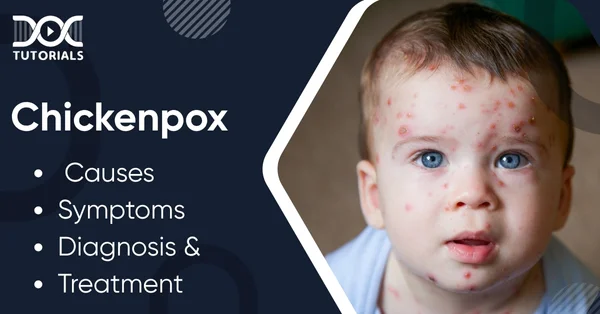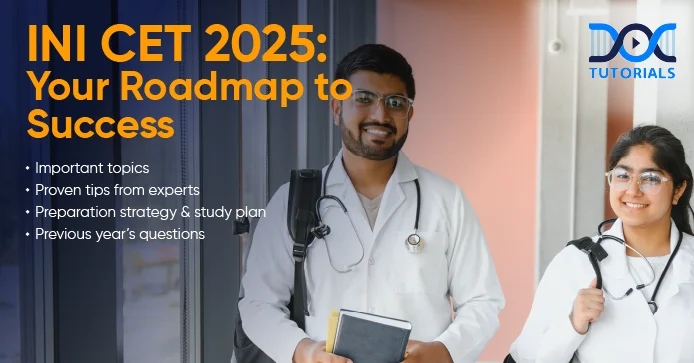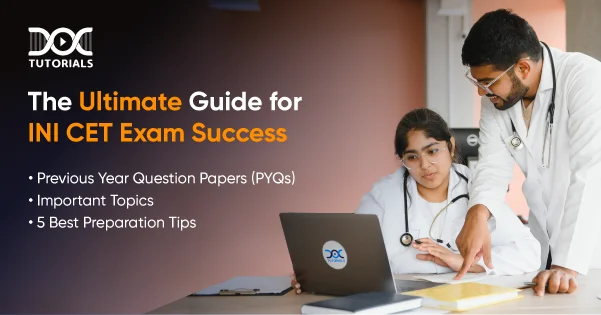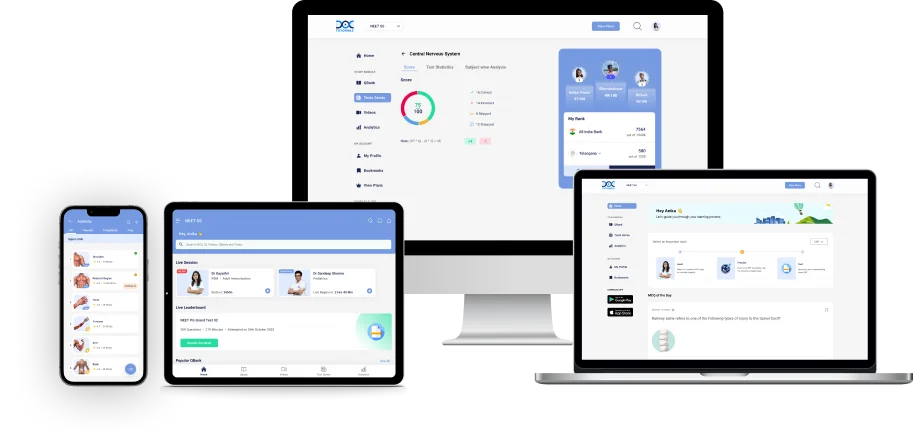Chickenpox: Causes, Symptoms, Diagnosis, and Treatment

According to the CDC, more than 4 million cases of chickenpox were reported prior to the development of the vaccine. Today, even after mass vaccination drives throughout the world, sporadic cases are still reported. Thus, if you are a NEET PG aspirant or a medical professional, it is ideal to have a comprehensive idea of the chicken pox stages, causes, diagnosis, treatment, and other essential factors.
It will not only help cover your syllabus but also assist in making accurate diagnoses when treating patients.
Keep reading for in-depth insight!
What is Chickenpox?
Chickenpox, caused by the varicella-zoster virus, is a highly contagious disease that primarily affects children but can occur at any age. It is characterised by itchy vesicular rashes along with fever, fatigue, and malaise.
This disease is transmitted via respiratory droplets or through direct contact with the rash. Chickenpox is generally not a serious condition for healthy children. However, it can lead to complications in adults or infants with compromised immune systems.
What are the Various Types of Chickenpox?
The chickenpox types are listed below:
- Primary Chickenpox: The most common form of chickenpox usually affects children who are more prone and susceptible to the virus. In primary chickenpox, a person has no prior exposure to the virus, and the body has not developed immunity.
- Secondary Chickenpox: In secondary chickenpox, the individual has been exposed to the virus before it causes reinfection, which happens frequently in adults. In this case, the virus reactivates from its dormant state in the sensory nerve ganglia, leading to a condition known as shingles.
What are the Three Stages of Chickenpox?
Listed below are the stages of chickenpox:
- Stage 1 presents as a red, bumpy rash that can persist for a few days. They are commonly seen on the face, chest, and back, and mark the chicken pox early stages.
- Stage 2 features a rash with fluid-filled blisters, which burst after approximately one to two days.
- Stage 3 occurs when the blisters begin to form scabs, and this stage also continues for several days.
Early-stage chicken pox rash baby often begins with mild symptoms like fever and tiredness, followed by the appearance of skin lesions. Understanding the stages of chickenpox helps identify the symptoms early and manage the condition effectively.
What are the Causes and Risk Factors of Chickenpox?
Read below to understand the key causes of chickenpox:
- Airborne Transmission:
- Inhalation of respiratory droplets via coughing or sneezing.
- It is the most common mode of transmission.
- Direct Contact:
- Touching fluid from the blisters of an infected person.
- The virus can be transmitted through direct skin contact.
- Indirect Contact:
- Touching surfaces, objects, or clothing contaminated with fluid from chickenpox lesions.
- The virus does not survive long on the surface, but transmission is still possible if contact is immediate.
- Transmission from Shingles:
- A person with shingles can spread the virus to someone who hasn’t had chickenpox or the vaccine, causing them to develop chickenpox.
The major risk factors of chickenpox that increase the chances of contraction are:
- Individuals who have not encountered the virus are vulnerable to getting infected.
- Close contact with someone contagious.
- Children under 12 years of age.
- Individuals who have not received a vaccination for chickenpox.
- People with compromised immune systems because of medical conditions or treatments.
What are the Symptoms of Chickenpox?
This disease is mild in children and more severe in adults, pregnant women, and immunocompromised individuals:
- Initial manifestations are fever and malaise, followed by the appearance of rashes.
- Rashes initially appear over mucous membranes and then spread in centripetal distribution over the skin.
- Initial lesions appear pruritic and maculopapular, which eventually evolve into vesicles, pustules, and then crusts.
- The patient is infectious till the crusts slough and separate.
What are the Diagnosis Methods for Chickenpox?
Diagnosis of chickenpox is usually done from the typical appearance of the lesions:
- Confirmation of infection is made by isolation of the virus on the tissue culture or by detection of viral DNA by PCR in the vesicular fluid or scraping.
- Serological diagnosis is achieved by demonstrating titers of antibodies.
- Multinucleated giant cells can be demonstrated by a Tzanck smear.
- Leukopenia, thrombocytopenia, and raised liver enzymes may be present.
What are the Treatment Options for Chickenpox?
While chickenpox often resolves on its own in healthy individuals, proper care is important to relieve discomfort and prevent complications. Mentioned below are the chickenpox treatment options:
- General:
- The patient is isolated till the complete sloughing of crusts.
- It is important to uphold personal cleanliness to avoid skin infections.
- Nails should be closely cropped.
- Agents to relieve itching, lukewarm water baths, and damp compresses to soothe discomfort.
- Aspirin should be avoided in patients as it can lead to Reye’s syndrome.
- Antiviral Medications:
These medications can significantly reduce the severity and duration of chickenpox when initiated early.
- Commonly Used Antivirals: Acyclovir (800mg orally 5 times a day), Valacyclovir (1g orally 3 times a day), or Famciclovir (250 mg orally thrice a day) for 7 days.
- Indications: Groups at higher risk include healthy individuals over 12 years of age, people with chronic skin or lung diseases, people receiving long-term salicylate therapy, pregnant women, and people with weakened immune systems.
FAQs About Chickenpox
- What is chickenpox, and what are its causes?
Chickenpox is a viral infection which leads to an itchy rash, fever, and fatigue, mostly in children. It is caused by the varicella-zoster virus.
- How is chickenpox spread from person to person?
Chickenpox spreads through respiratory droplets or direct contact with the fluid from the blisters. It’s contagious from 1–2 days before the rash until scabs form.
- What are the common symptoms of chickenpox?
Symptoms include fever, tiredness, loss of appetite, and a red, itchy rash that turns into fluid-filled blisters and later scabs.
- Can you get chickenpox more than once?
Reinfection is rare. Most people gain lifelong immunity after one infection, though rare second cases can occur in those with weak immunity.
- Is there a vaccine for chickenpox, and who should get it?
Yes, the varicella vaccine is recommended for children, teens, and adults who haven’t had chickenpox. It helps prevent or lessen disease severity.
Conclusion
Learning about chickenpox in detail is crucial for every medical student, especially when preparing for competitive exams like NEET PG. It will improve your overall idea of infectious diseases like chickenpox and help you accurately diagnose the condition in clinical settings.
To aid in preparation, DocTutorials offers access to a large repository of topics related to medicine, anatomy, obstetrics, pharmacology, and more. You can also get concise video lectures, high-yield notes, question banks, mock tests, and more. Check out our NEET PG study materials today!
Latest Blogs
-

INI CET Exam 2025: Your Roadmap to Success – Key Topics, Strategies, and Lessons from Last Year’s Papers
The INI CET exam is more than just a test; it’s a significant milestone for many medical students aiming to…
-

INI CET Exam Success: Previous Year Question Papers & Ultimate Guide – INI CET PYQ
One can feel overwhelmed while preparing for the INI CET (Institute of National Importance Combined Entrance Test). A vast syllabus,…
-

INI CET Exam Pattern 2024: A Complete Guide with Subject-Wise Weightage
The Institute of National Importance Combined Entrance Test (INI CET) is your key to entering some of the most prestigious…




